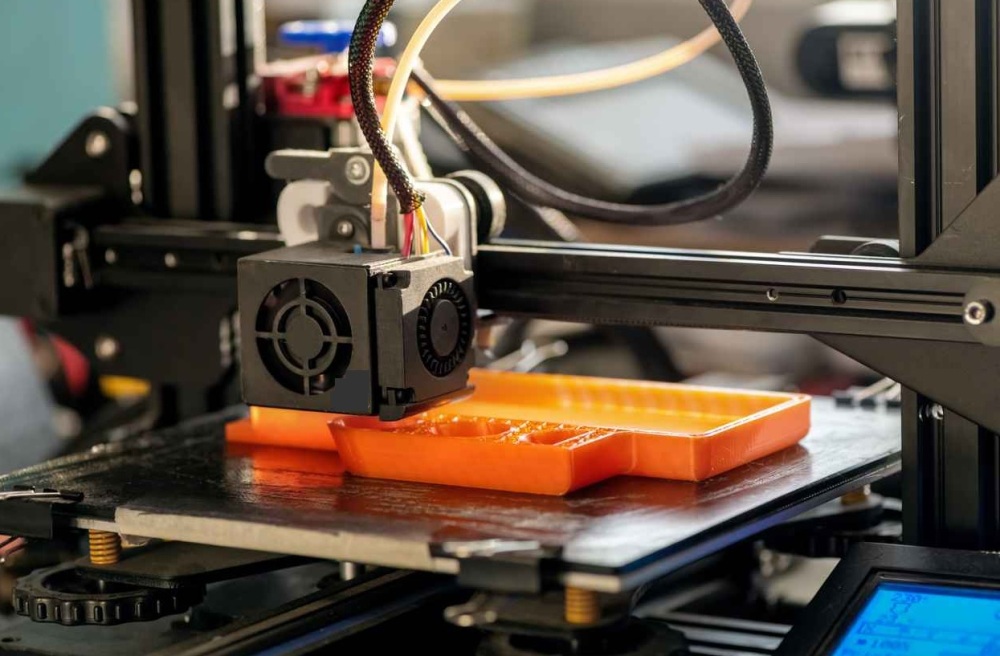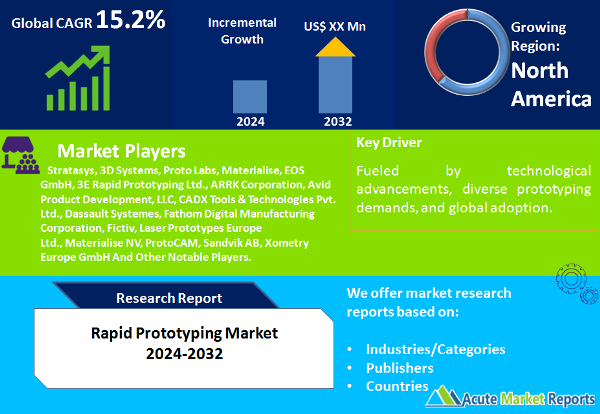
The rapid prototyping market is expected to grow at a CAGR of 15.2% during the forecast period of 2025 to 2033, fueled by technological advancements, diverse prototyping demands, and global adoption. While cost constraints pose a challenge, strategic initiatives by key players and increasing awareness among SMEs are expected to mitigate this restraint. The segmentation analysis highlights the dominance of different processes and prototype types at different stages, offering insights for businesses to align their strategies accordingly. Geographically, the market's trajectory underscores the significance of Asia-Pacific in driving future growth. As competition intensifies, key players are gearing up for a dynamic market landscape, emphasizing innovation and collaboration to maintain their market positions. Overall, the rapid prototyping market presents lucrative opportunities for players across the value chain, provided they navigate the evolving landscape with agility and foresight.
Technological Advancements in Prototyping Processes
The rapid prototyping market is propelled by continuous technological advancements in prototyping processes. Stereolithography (SLA), Selective Laser Sintering (SLS), Fused Deposition Modeling (FDM), and Multi Jet Fusion (MJF) are key processes driving innovation. These technologies enable the rapid creation of prototypes with enhanced precision and complexity. Companies such as 3D Systems and Stratasys have been at the forefront, introducing cutting-edge solutions that cater to diverse industry needs. For instance, Stratasys' FDM technology has gained widespread adoption in aerospace and automotive applications, demonstrating the impact of technological advancements on market growth.
Increasing Demand for Diverse Prototyping Types
Another driving force in the rapid prototyping market is the increasing demand for diverse prototyping types. Proof-of-concept (PoC) prototypes, functional prototypes, visual prototypes, and user experience prototypes serve varying purposes in the product development lifecycle. Companies like Proto Labs and Materialise offer a range of prototyping services, addressing the evolving needs of industries such as healthcare, consumer goods, and electronics. The versatility in prototype types not only accelerates product development but also contributes to improved design iterations, reducing time-to-market.

Growing Adoption Across Geographic Segments
The rapid prototyping market is experiencing robust growth globally, with distinct geographic trends. Regions with the highest Compound Annual Growth Rate (CAGR) include Asia-Pacific, particularly driven by increased manufacturing activities in countries like China and India. North America and Europe, with established manufacturing sectors, also contribute significantly to market expansion. The demand for rapid prototyping services in these regions is fueled by the need for quick product validation and customization. Companies like Proto Labs and 3D Systems have strategically expanded their presence in these regions to capitalize on the growing adoption of rapid prototyping technologies.
Cost Constraints in Rapid Prototyping Adoption
Despite the positive momentum, the rapid prototyping market faces a restraint in the form of cost constraints. The initial investment in advanced prototyping technologies can be substantial for small and medium-sized enterprises (SMEs). This financial barrier limits the widespread adoption of rapid prototyping, particularly among smaller players in emerging markets. The evidence for this restraint is apparent in the slower adoption rates observed in regions with a higher concentration of SMEs.
Market by Process Segmentation: FDM Dominates the Market
The rapid prototyping market is segmented by various processes, including Stereolithography (SLA), Selective Laser Sintering (SLS), Fused Deposition Modeling (FDM), Multi Jet Fusion (MJF), and others such as Digital Light Processing (DLP) and Electron Beam Melting (EBM). In 2024, FDM emerged as the highest revenue-generating process, driven by its widespread use in various industries. However, during the forecast period from 2025 to 2033, MJF is expected to exhibit the highest CAGR. The adoption of MJF is anticipated to surge due to its ability to produce complex prototypes with improved efficiency.
Market by Type: Functional Prototypes Dominate the Market
Further segmentation based on prototype types includes Proof-of-Concept (PoC) prototypes, functional prototypes, visual prototypes, and user experience prototypes. In 2024, functional prototypes contributed the highest revenue, given their crucial role in product testing and validation. Looking ahead to the period from 2025 to 2033, user experience prototypes are projected to have the highest CAGR. This shift reflects the growing emphasis on user-centric design and the importance of creating prototypes that closely simulate the end-user experience.
North America Remains the Global Leader
Geographically, the rapid prototyping market exhibits distinct trends. Asia-Pacific is anticipated to have the highest CAGR during the forecast period, driven by increased industrialization and manufacturing activities. North America is expected to maintain its position with the highest revenue percentage in 2024, owing to a mature manufacturing sector and robust adoption of advanced prototyping technologies. Europe, although slightly behind North America in revenue, is poised for steady growth. These trends align with the global shift towards digital manufacturing and the emphasis on rapid product development.
Market Competition to Intensify during the Forecast Period
The rapid prototyping market is marked by intense competition among key players. Stratasys, 3D Systems, Proto Labs, Materialise, EOS GmbH, 3E Rapid Prototyping Ltd., ARRK Corporation, Avid Product Development, LLC, CADX Tools & Technologies Pvt. Ltd., Dassault Systemes, Fathom Digital Manufacturing Corporation, Fictiv, Laser Prototypes Europe Ltd., Materialise NV, ProtoCAM, Sandvik AB, and Xometry Europe GmbH are prominent companies shaping the competitive landscape. Strategies employed by these players include continuous innovation in prototyping technologies, strategic collaborations, and global expansions. In 2024, Stratasys led in terms of revenue, leveraging its diversified product portfolio catering to various industries. Over the forecast period from 2025 to 2033, all key players are expected to focus on R&D, partnerships, and acquisitions to maintain their competitive edge. The emphasis on addressing industry-specific needs and providing end-to-end prototyping solutions is anticipated to drive the market forward.
Historical & Forecast Period
This study report represents analysis of each segment from 2023 to 2033 considering 2024 as the base year. Compounded Annual Growth Rate (CAGR) for each of the respective segments estimated for the forecast period of 2025 to 2033.
The current report comprises of quantitative market estimations for each micro market for every geographical region and qualitative market analysis such as micro and macro environment analysis, market trends, competitive intelligence, segment analysis, porters five force model, top winning strategies, top investment markets, emerging trends and technological analysis, case studies, strategic conclusions and recommendations and other key market insights.
Research Methodology
The complete research study was conducted in three phases, namely: secondary research, primary research, and expert panel review. key data point that enables the estimation of Rapid Prototyping market are as follows:
Market forecast was performed through proprietary software that analyzes various qualitative and quantitative factors. Growth rate and CAGR were estimated through intensive secondary and primary research. Data triangulation across various data points provides accuracy across various analyzed market segments in the report. Application of both top down and bottom-up approach for validation of market estimation assures logical, methodical and mathematical consistency of the quantitative data.
| ATTRIBUTE | DETAILS |
|---|---|
| Research Period | 2023-2033 |
| Base Year | 2024 |
| Forecast Period | 2025-2033 |
| Historical Year | 2023 |
| Unit | USD Million |
| Segmentation | |
Process
| |
Type
| |
Material
| |
End-Use
| |
|
Region Segment (2023-2033; US$ Million)
|
Key questions answered in this report